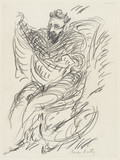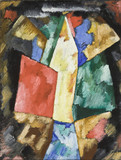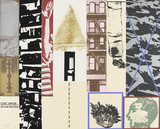Marsden Hartley (born Edmund Hartley) was among the most innovative of early American modernists. He led a peripatetic life during his adulthood, never remaining in one place for more than nine months. With this constant moving came changes in his art as he explored the gamut of European avant-garde styles and evolved a truly personal means of expression, yet his home state of Maine and nature in general played a crucial role in Hartley’s art. In the late 1890s he took his first art lessons in Cleveland, Ohio, with local artists such as Cullen Yates (1866-1945) and at the Cleveland School of Art; he then moved to New York, attending the Chase School and later the National Academy of Design for four years. In 1909 his impressionist and neoimpressionist landscapes were shown at his first solo exhibition in New York at Alfred Stieglitz’s gallery "291"; this initiated his long association as an intimate of the Stieglitz circle.
During four years spent in France and Germany before World War I Hartley immersed himself in European avantgarde circles and, fascinated with the ideas of the cubists and Wassily Kandinsky (1866-1944), began to create his own mystical abstractions. In Berlin during 1915 he painted symbolic abstractions inspired by the pageantry of military displays and by Native American art. He painted his most abstract, cubist works during 1916, when he spent the summer in Provincetown, Rhode Island, with CHARLES DEMUTH. He then returned to representational painting and from 1918 to 1919 fell under the spell of the desert and Native American imagery during visits to New Mexico. Despite a brief Cezannesque period in the late 1920s, Hartley grew increasingly expressionistic in his handling of paint while retaining his romantic view of nature. His dramatic landscapes and figurative compositions culminated in the paintings he created in Nova Scotia and Maine during the late 1930s and 1940s.
Hartley was also a prolific writer, the largest body of his published work appearing between 1917 and 1923. He wrote poems as early as 1902. Many of his writings remain unpublished and are in the collection of the Beinecke Library, Yale University His essays appeared in The Dial, Nation, and other magazines, and some were published in Adventures in the Arts (1923). Two anthologies have recently been published, On Art (1982) and The Collected Poems of Marsden Hartley, 1904-1943 (1987), both edited by Gail R Scott.
BIBLIOGRAPHY
Paul Rosenfeld, Port of New York (1924; reprint, Urbana: University of Illinois Press, 1966), pp. 83-101 § "Marsden Hartley: Special Issue," Arts Magazine 54 (October 1979): 154-76, articles by Gail Levin, Gail R. Scott, Roxana Barry, and Vivian Endicott Barnett § New York, Whitney Museum of American Art, and others, Marsden Hartley, exh. cat., 1980 (copublished by New York University Press, New York), text by Barbara Haskell, chronology, list of exhibitions, bibliography of Hartley’s published writings compiled by Peter Freeman § Halifax, Nova Scotia, Canada, Mount Saint Vincent University Art Gallery, and Toronto, Art Gallery of Ontario, Marsden Hartley and Nova Scotia, exh. cat., 1987, published by Press of Nova Scotia College of Art and Design, ed. Gerald Ferguson, with essays by Ronald Paulson and Gail R. Scott, reprints of Hartley’s letters to Adelaide Kuntz, 1936 journal entries, essay "Cleophas and His Own" and related poems, with chronology, bibliography § Gail R. Scott, Marsden Hartley (New York: Abbeville Press, 1988), with chronology; lists of exhibitions and public collections, bibliography.



